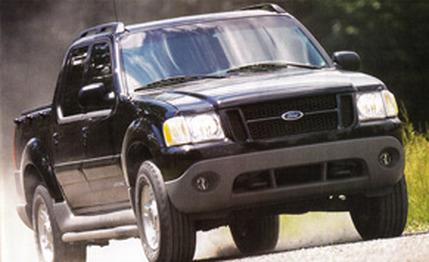 Road Test
Road Test
Compromise involves giving up something to get something in return, and until recently that has been the case with choosing an SUV or a pickup. With an SUV you have to give up carrying messy loads like wood chips or mulch in order to more comfortably haul a load of passengers. With a pickup just the opposite is true, and it rides and handles like, well, a truck.
Ford seems to have come up with a solution to the compromise problem with the Explorer Sport Trac. It can comfort-ably haul four adults to the opera, a couple of dirt bikes or a load of mulch in the bed, and tow Jet Skis to the lake. Ford is targeting the Gen Xers who like to get down and dirty but don't want to give up com-fort and space.
The Sport Trac is a five-door Explorer that has had its frame stretched and its rear cargo compartment lopped off and replaced with a truncated pickup box. The frame has been lengthened by 14.3 inches, and it's 40 percent stiffer laterally due to the addition of a crossmember, thicker frame side rails, and more gussets on the frame's longitudinal beams. The enclosed cargo area just aft of the rear seats is replaced by a cargo box made of sheet-molding composite (SMC) plastic, which is 20 percent lighter than steel and more durable. The tailgate and its frame are steel, however, taken directly from the F-150 parts bin. Our truck came equipped with the optional cargo-box tonneau cover that is hinged in the center and has locks at the front and rear to thwart prying eyes and sticky fingers. It's also made out of SMC and weighs about 70 pounds. Removing it is a two-person operation.
We drove through two drenching rain storms and afterward found nary a puddle in the bed, so it looks as though the cargo box can be used for luggage, which leaves room for five passengers up front.
Another distinguishing feature of the Sport Trac is its new front-end styling, which it shares with the three-door Explorer Sport. There's the bulging "power dome" hood, a honey-combed grille, more radically flared fenders, and a two-tone bumper fascia. The upper part of the fascia is body-colored, and the lower part is a silver titanium color. To further emphasize the rugged nature of this beast, there are also two large tow hooks in the opening of the bumper.
These exterior changes do make the Explorer five-door look pretty punk in comparison, although there are those on staff who find the Sport Trac unattractive to the max. What's undisputed is the fact that it definitely stands out among the crowded SUV herd. We got looks and questions wherever we ventured.
The carpeting has been replaced with a textured rubber flooring with removable Berber floor mats so the interior can, literally, be hosed clean. The padded rubber floor covering and the use of urethane rather than solid rubber body mounts help deaden road noise. The Sport Trac was slightly quieter at speed, 70 dBA vs. 72 dBA, than the last Explorer we tested. The gauge faces in the instrument cluster are white with black numerals and lettering. The green color that appears at night is not a good idea, and some said it makes the gauge faces difficult to read clearly. There is a knob on the dash to lower or raise the standard power back-light; this feature comes in handy for hauling extra-long pieces of lumber without having them sticking out the back of the bed. The rear seats were comfortable for two adults but snug in the shoulders for three. The 60/40 split seats fold flat for extra hauling space, and there are a couple of storage bins behind them as well.
The only engine available is an SOHC 4.0-liter V-6 that puts out 205 horsepower and 240 pound-feet of torque. It propelled our 4337-pound vehicle from 0 to 60 mph in 9.5 seconds, about average for this class of vehicle. Our Sport Trac came equipped with a five-speed automatic transmission, and Ford's Control Trac four-wheel-drive system takes its orders from a rotary switch on the dash. Rear-wheel drive and a five-speed manual transmission are available and would probably cut at least a second off the 0-to-60 time.